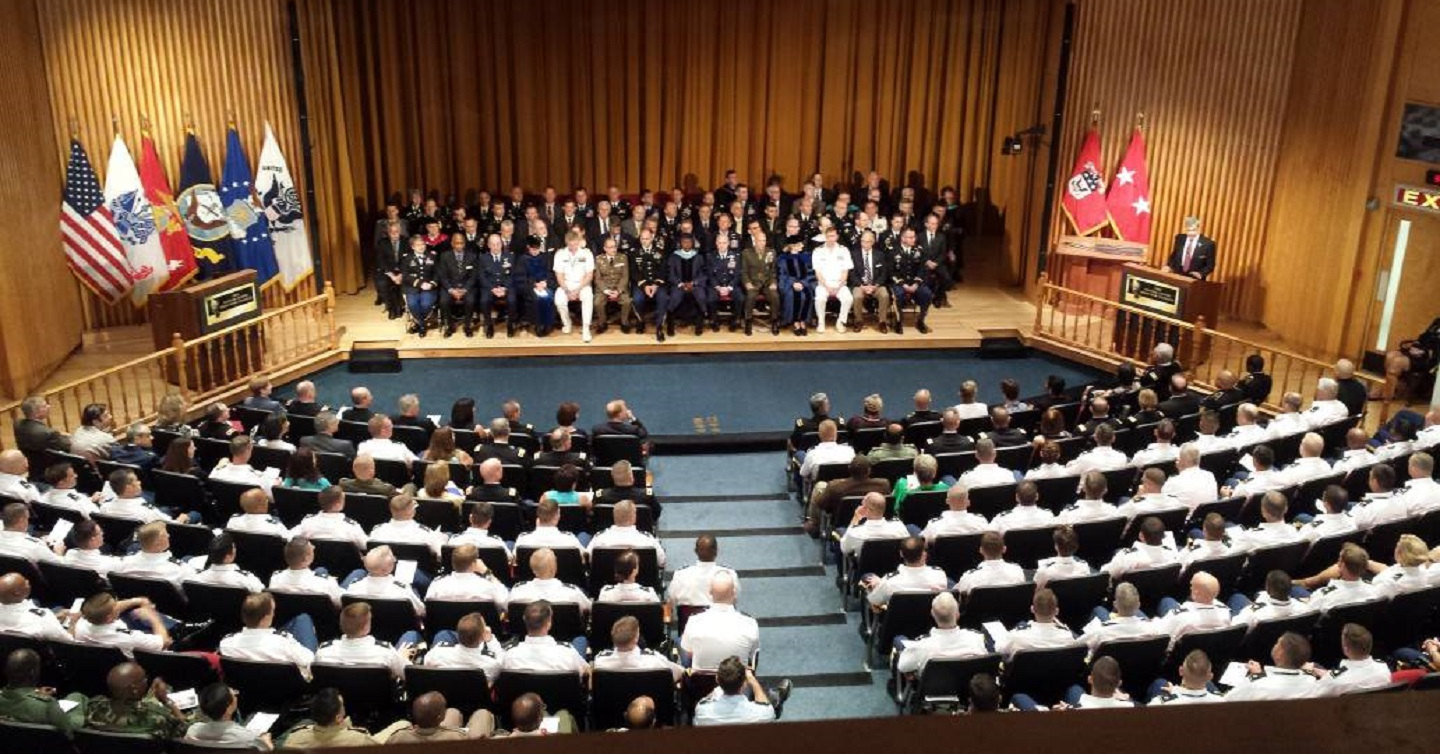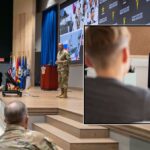
Every voice will bring something a little bit different and that particular voices have particular things to add.
For the past century we have been discussing diversity in some form or fashion in the United States Department of Defense. There have obviously been great strides but many would argue there is still a long way to go. A complicated topic that will require many detailed considerations, the conversation must continue in order to find a successful path forward.
A BETTER PEACE welcomes Megan Hennessey and Brandy Jenner to continue the conversation specifically about diversity in professional military education. They join Ron Granieri in the studio to discuss the Army War College’s approach to diversity, both amongst the students and the faculty as well.
Podcast: Download
Megan J. Hennessey, Ph.D., is the Professor of Educational Methodology at the U.S. Army War College. Brandy M. Jenner, Ph.D., is a Post-doctoral fellow in the Department of Educational Methodology at the U.S. Army War College. Ron Granieri is an Associate Professor of History at the U.S. Army War College and the Editor of A BETTER PEACE. The views expressed in this presentation are those of the speakers and do not necessarily reflect those of the U.S. Army War College, U.S. Army, or Department of Defense.
Photo Description: Convocation ceremony for the Resident Academic Year Class of 2014 at the U.S. Army War College
Photo Credit: U.S. Army War College Public Affairs





DIVERSITY IN PROFESSIONAL MILITARY EDUCATION
https://warroom2.armywarcollege.edu/podcasts/diversity-in-pme/
This segment appears to promote creativity through diversity but appears to be a “Social Justice” screed masquerading as science.
This podcast doesn’t cite the standard academic literature on diversity in thinking styles versus diversity in identity. This literature identifies different thinking styles as important for diverse groups to work effectively. The four thinking styles have differences in: perspectives on problem solving, intuitions, predictions, and heuristics.
Further, the academic literature shows that intellectual diversity is not equivalent to race, gender, national origin, or sexual orientation. Some times diversity based on national origin or race is helpful but other times not.
The U.S. Marine Corps tests of all men infantry units and mixed men and women units showed diversity in ground combat units reduced effectiveness rather than increase it.
This podcast claims that adding women to mix enhances creativity. This podcast doesn’t cite the standard academic literature on creativity. The standard academic literature cites four different thinking styles for creativity. Those thinking styles are: clarifier, ideator, developer, and implementor. Nor do they talk about the FourSight Thinking Profile which is a test to evaluate one’s creative thinking styles.
Does not distinguish between tasks needing diversity and tasks need specialization.
As Forbes has reported, Israel has an innovation factory but it is not diverse based on race. The podcast didn’t reference one of the Israel Defense Forces prime labs for creating innovation.
While the two presenters claimed that their research showed the benefits of diversity, they didn’t discuss the academic basis for their research nor whether they met the standards for scientific proofs. One scientific standard is whether there are tests to attempt to falsify the theory. Confirmation alone, is not a proof. The two presenters didn’t identify journals where their research results were replicated by independent researchers.
Suppose a woman officer had five children during her term of service. With 12 weeks of maternity leave, she could take off 60 weeks. A man officer, without that maternity leave, he would serve / work 20 years to a pension. The woman officer would serve / work less than 19 full years to a pension. That is not fair.
Without this additional support, one would be led to suspect that this is “Social Justice” ideas pretending to be valid research.
The links below support the above assertions.
The presenters cite papers. Unfortunately, we don’t know whether those papers represent valid science?
The Irreproducibility Crisis of Modern Science: Causes, Consequences, and the Road to Reform
https://nas.org/reports/the-irreproducibility-crisis-of-modern-science
The Difference: How the Power of Diversity Creates Better Groups, Firms, Schools, and Societies by Scott Page
Page 34
In part I, I unpack the first component of the Diversity Conjecture, diversity itself. Without that unpacking, we would be left to wander about in a land of catch phrases and vague metaphors. We cannot say whether diversity is good or bad unless we first know what diversity is. By diversity, I mean cognitive differences.3 The unpacking consists of four formal frameworks.
The first framework captures the idea that people have diverse perspectives. Informally speaking, perspectives represent solutions to a problem. When we say that people have diverse perspectives, we mean that they see or envision the set of possibilities differently.
Perspectives embed knowledge: what we know is a function of how we represent things.4 To provide just one example, Isabelle, an Ann Arbor resident, might represent a location relative to her home—“To get to Zingerman’s, go down State Street and take a left in front of the big Catholic Church.” Her brother, Nicky, might represent those same locations using a mental map of city streets—“Zingerman’s sits on the corner of Kingsley and Detroit.” Given their perspectives, Nicky would prove far more capable of telling a visitor how to get from Zingerman’s to the Brown Jug, another Ann Arbor landmark. Isabelle might resort directions that pass by her house. (Or, like the old New Englander, tell you, “You can’t get there from here.”)
Perspectives provide one framework for how people see the world differently. A second framework, interpretations, highlights the different categories people use to classify events, outcomes, and situations. For example, one financial analyst might categorize companies by their equity value, while another might categorize them by industry. One voter might categorize senators by their ideology. Another might categorize them by their home state. The first refers to Olympia Snowe as a Republican. The second refers to her as a Mainer. Formally speaking, interpretations create many-to-one mappings from the set of alternatives that form categories. Informally speaking, interpretations lump things together.
A third framework captures the different tools people use to solve problems. I call these heuristics. These can range in sophistication from simple rules of thumb—if it’s bleeding put a bandage on it; no blood, no foul—to sophisticated analytic techniques such as Fourier analysis or wavelet transforms.5 Heuristics must be applied with respect to a particular representation of a problem, a perspective, so I’ll often speak of perspective/heuristic pairs. Because people
often apply heuristics in combination, a person who knows two heuristics often knows three—the third being the combination of the first two. Often these combined heuristics prove far more powerful than the individual heuristics that form them.
The fourth framework for capturing cognitive diversity, predictive models, describes causal relationships between objects or events. Predictive models serve as a shorthand to make sense of the world. When someone says Nebraskans are nice people or Ford trucks are durable, they map categories—Nebraskans and Ford trucks—onto the categories nice people and durable machines. Predictive models can differ: Ben Franklin believed that “cheese and salty meat should be sparingly eat.” Doctor Atkins believed differently. Both sold lots of books.
If we combine perspectives, interpretations, heuristics, and predictive models, we create cognitive toolboxes.6 These toolboxes provide a new way to think about intelligence and ability. We often think of people as having a level of intelligence as measured by an IQ test—where they fall on a scale that starts at zero and goes up (way up, in some cases). IQ provides us with a convenient measuring stick. The move from measuring sticks to toolboxes obliges more than a switch of metaphors. Toolboxes change how we conceive of intelligences and how we compare them.
Pg 262
In much of what follows, we distinguish between studies that focus on training and vocational diversity and those that look at identity diversity. Overall, the evidence agrees with our logic: cognitive diversity improves performance at problem solving and predictive tasks. The evidence for identity diverse groups, though, is far from unequivocal. Some identity diverse groups perform well. Others do not. The same is true of identity diverse cities and countries. This makes sense, given the conditional nature of the logic. First, the linkages between identity diversity and cognitive diversity may not be strong in all cases. Second, many identity diverse groups have differences in their fundamental preferences, which, as we’ve seen, cause problems. Third, people who differ often have trouble communicating and getting along. Nevertheless, if we look closely at the evidence across the scales— groups, cities, and countries—we find that well-managed identity diversity does produce benefits.